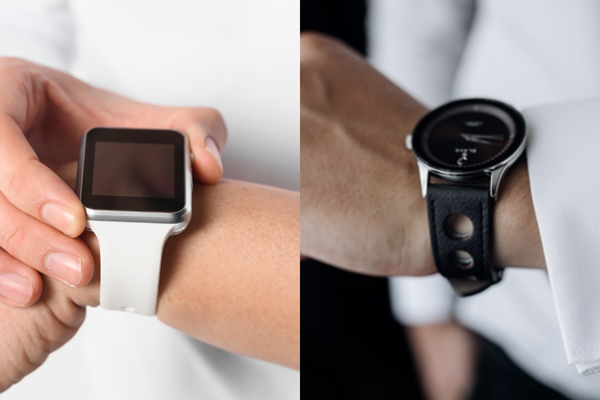Watches have long been a symbol of style, precision, and technological advancement. From their origins as simple timekeeping devices to the sophisticated gadgets we use today, the evolution of watches is a testament to human ingenuity. Traditional watches, with their intricate mechanical movements and classic designs, once represented the pinnacle of horological craftsmanship. However, the advent of smartwatches has transformed the landscape, merging timeless elegance with cutting-edge technology. This article explores the comparison of smartwatches and traditional watches, highlighting key innovations and the impact of this evolution on how we perceive and use watches today.

I. Introduction
A. Overview of Smartwatches and Traditional Watches
Smartwatches and Traditional Watches categories represent two distinct worlds in timekeeping, each with unique features and characteristics. The traditional watch is renowned for its classic design, timeless elegance, and mechanical precision. In contrast, the smartwatch epitomizes modern technology with digital capabilities, connectivity, and multifunctionality. Understanding the essence of these devices requires delving into their definitions, characteristics, and current popularity trends.
Traditional watches are mechanical or quartz timepieces that focus primarily on telling time with precision. They often feature intricate designs and durable materials, appealing to those who appreciate craftsmanship and elegance. On the other hand, smartwatches integrate digital technology, offering features such as notifications, health tracking, and app support, making them versatile tools for modern living.
B. Purpose of the Comparison
The purpose of this smartwatches and traditional watches comparison is to highlight the key differences and similarities between these two types of timepieces. By examining their design, functionality, performance, and value, we aim to provide a clear understanding of each type’s advantages and disadvantages. This comparison will help readers make informed decisions based on their needs and preferences.
C. Objectives of the Article
This article seeks to offer a detailed side-by-side comparison of smartwatches and traditional watches, exploring various aspects including design, functionality, performance, and cost. By analyzing both types, we aim to assist readers in making an informed choice that aligns with their lifestyle and requirements.
II. Design and Aesthetics
A. Traditional Watches
Classic Design Elements
The traditional watch is characterized by its classic design elements such as analog dials, hands, and markers. These features contribute to a timeless appeal that has been cherished for centuries. The intricate craftsmanship involved in creating mechanical movements and the aesthetic details of the dial make traditional watches a symbol of elegance and sophistication.
Materials Used
Traditional watches often utilize premium materials like leather for straps, stainless steel or precious metals for cases, and high-quality glass for the crystal. These materials not only enhance the durability of the watch but also add to its luxurious appearance.
Customization Options
Traditional watches offer various customization options, including engravings on the case or back, interchangeable bands, and bespoke designs. This level of personalization allows owners to create a unique timepiece that reflects their style.
B. Design and Aesthetics
Modern Design Features
The smartwatch showcases modern design features such as digital displays and touch screens. These elements enable users to interact with the watch through intuitive interfaces, offering a futuristic look compared to the classic design of traditional watches.
Materials and Build
Smartwatches are often constructed using materials such as silicone for bands, aluminum or ceramic for cases, and reinforced glass for screens. These materials are chosen for their durability and comfort, catering to the active lifestyles of smartwatch users.
Customization through Watch Faces and Bands
Unlike traditional watches, smartwatches offer extensive customization options through digital watch faces and interchangeable bands. Users can easily change the appearance of their smartwatch to suit their mood or occasion.
III. Functionality and Features
A. Traditional Watches
Basic Timekeeping and Mechanical Precision
The primary function of a traditional watch is to keep accurate time. Mechanical watches rely on intricate gear systems, while quartz watches use battery-powered movements. Both types offer reliable timekeeping with a focus on precision and craftsmanship.
Additional Features
Some traditional watches come with additional features such as clocksdate functions. These complications add functionality and complexity to the watch, making it more versatile for enthusiasts.
Durability and Longevity
Traditional watches are known for their durability and longevity. Mechanical watches, in particular, can last for generations if well-maintained. Their robust construction and classic design contribute to their enduring appeal
B. Smartwatches
Digital Functions
Smartwatches offer a range of digital functions, including notifications for calls, messages, emails, and social media. They can run various apps, enabling users to check the weather, set reminders, or control smart home devices.
Health and Fitness Tracking
One of the standout features of smartwatches is their health and fitness tracking capabilities. They can monitor heart rate, track physical activity, measure sleep quality, and even provide GPS navigation. These features cater to health-conscious users and those seeking to improve their fitness.
Connectivity Features
Smartwatches come equipped with connectivity features like Bluetooth, Wi-Fi, and cellular options. These capabilities allow them to sync with smartphones and other devices, ensuring seamless integration with digital ecosystems.

IV. Performance and Battery Life
A. Traditional Watches
Battery Mechanisms
Traditional watches use various battery mechanisms, including quartz movements powered by batteries and mechanical movements requiring manual winding or automatic motion. Quartz watches generally offer higher accuracy and longer battery life, while mechanical watches require regular maintenance.
Maintenance Requirements and Longevity
Traditional watches, especially mechanical ones, require periodic maintenance to ensure optimal performance. Regular servicing can prolong the life of the watch and maintain its accuracy. Quartz watches, on the other hand, need less frequent maintenance but may require battery replacements.
B. Smartwatches
Battery Life and Charging Cycles
Smartwatches typically have shorter battery lives compared to traditional watches, often requiring daily or bi-daily charging. The battery life can vary depending on the model, usage, and features enabled.
Power-Saving Features and Limitations
To manage battery life, smartwatches often include power-saving features such as screen dimming, limited notifications, and reduced use of GPS. Despite these features, the need for regular charging remains a notable limitation.
V. Usability and Convenience
A. Traditional Watches
Ease of Use and Wearability
Traditional watches are known for their straightforward functionality and ease of use. They provide a reliable means of timekeeping without the need for technology or complex interactions. Their design often prioritizes comfort and wearability.
Comfort and Style Considerations
Traditional watches are designed to be stylish and comfortable. The materials used, such as leather straps and metal cases, contribute to a refined appearance while ensuring a comfortable fit.
B. Smartwatches
User Interface and Interaction
Smartwatches offer a digital user interface that allows for interactive experiences, including touch gestures and voice commands. This interface can provide a dynamic and responsive user experience, catering to modern needs.
Integration with Other Devices and Services
One of the key advantages of smartwatches is their ability to integrate with other devices and services. They can sync with smartphones, smart home systems, and health apps, creating a cohesive digital experience.
VI. Cost and Value
A. Traditional Watches
Price Ranges and Market Segments
Traditional watches span a wide range of price points, from affordable quartz models to high-end luxury timepieces. The price often reflects the materials, craftsmanship, and brand prestige.
Investment Value and Resale Potential
Some traditional watches, particularly those from renowned brands, can hold or increase in value over time. They are often considered collectible items and can have significant resale potential.
B. Smartwatches
Price Ranges and Models
Smartwatches are available in various price ranges, from budget-friendly options to premium models with advanced features. The cost is influenced by the brand, features, and technology incorporated into the watch.
Cost vs. Functional Value
While smartwatches can be relatively expensive, their value is often justified by their multifunctionality and digital capabilities. They offer a range of features that can enhance daily life and productivity.

VII. Lifestyle and Usage
A. Traditional Watches
Cultural and Fashion Significance
Traditional watches are often associated with cultural and fashion significance. They are seen as symbols of status and style, and their classic designs make them suitable for formal occasions and professional settings.
Suitable Occasions and Settings
Traditional watches are versatile in their use, fitting well with various occasions, from everyday wear to special events. Their design and craftsmanship make them appropriate for a wide range of settings.
B. Smartwatches
Practical Uses for Daily Life and Work
Smartwatches are designed to integrate seamlessly into daily life, offering practical features such as notifications, calendar reminders, and health tracking. They cater to individuals seeking convenience and functionality in their everyday activities.
Fitness and Activity Integration
The health and fitness tracking capabilities of smartwatches make them ideal for users who engage in regular physical activity. Features like heart rate monitoring and GPS tracking can enhance workout routines and help users achieve their fitness goals.
VIII. Trends and Future Developments
A. Traditional Watches
Current Design Trends and Technological Advances
Traditional watchmakers are incorporating modern design trends and technological advances into their creations. Innovations such as hybrid models that combine analog and digital elements are gaining popularity.
Future Innovations and Market Directions
The future of traditional watches may involve further integration of technology while maintaining classic aesthetics. Advancements in materials and movements could influence the direction of traditional watchmaking.
B. Smartwatches
Emerging Technologies and Features
Smartwatches are continually evolving with emerging technologies such as advanced health sensors, improved connectivity, and enhanced user interfaces. Future developments may include more sophisticated features and better integration with other digital systems.
Potential Advances and Future Trends
The future of smartwatches holds exciting possibilities, including increased battery life, more precise health monitoring, and greater customization options. Trends may also include improved integration with emerging technologies like AI and AR.
IX. Case Studies and Examples
A. Notable Traditional Watches
Examples of Iconic Models and Brands
Traditional watches include models from renowned brands such as Rolex, Patek Philippe, and Omega. These watches are celebrated for their craftsmanship, design, and historical significance.
User Experiences and Reviews
Users of traditional watches often praise their durability, style, and timeless appeal. Reviews highlight the craftsmanship and value of these timepieces, contributing to their continued popularity.
B. Leading Smartwatches
Major Brands and Innovations
Leading brands in the smartwatch market include Apple, Samsung, and Garmin. Their innovations have set benchmarks in functionality, design, and performance.
User Feedback and Performance Analysis
Users of smartwatches appreciate their multifunctionality and convenience. Feedback often focuses on the integration of health-tracking features, user interface quality, and overall performance.
X. Conclusion
A. Summary of Key Comparisons
Recap of Key Differences and Similarities
The smartwatches and traditional watches comparison highlights distinct differences in design, functionality, and usability. Traditional watches are valued for their classic design and craftsmanship, while smartwatches offer modern technology and versatility.
Pros and Cons of Each Type
Traditional watches offer timeless elegance and durability, while smartwatches provide digital capabilities and health tracking. Each type has its advantages and limitations, catering to different preferences and needs.
B. Guidance for Choosing Between Smartwatches and Traditional Watches
Final Recommendations for Making an Informed Decision
When making a decision, consider factors such as design preferences, functionality requirements, and budget. Both smartwatches and traditional watches offer unique benefits, and the choice ultimately depends on personal needs and style.
Considerations Based on Individual Needs and Preferences
Choosing between smartwatches and traditional watches depends on individual preferences, lifestyle, and desired features. Those seeking classic design and precision may prefer traditional watches, while those looking for modern functionality may opt for smartwatches.

